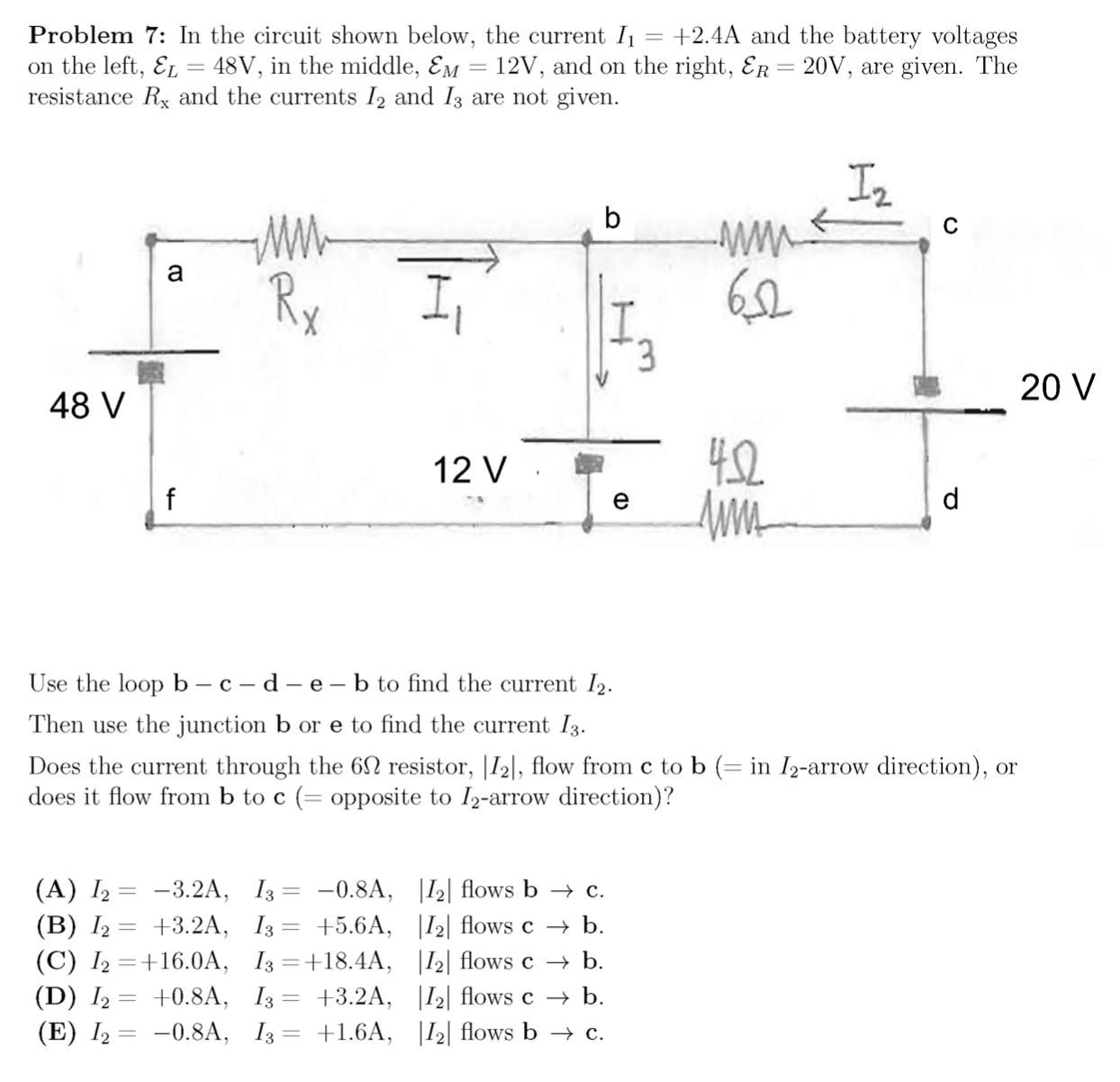Problem 7: In the circuit shown below, the current I1 on the left, E1 = 48V, in the middle, Em = 12V, and on the right, Er = 20V, are given. The resistance Rx and the currents I2 and I3 are not given. +2.4A and the battery voltages I2 b Rx I, I. 3. 20 V 48 V 42 12 V Use the loop b – c – d – e - b to find the current I2. Then use the junction b or e to find the current I3. Does the current through the 6N resistor, |I2|, flow from c to b (= in I2-arrow direction), or does it flow from b to c (= opposite to I2-arrow direction)? %3D (A) I2 (B) I2 (C) I2 =+16.0A, I3=+18.4A, |I2| flows c → b. (D) I, (E) 12 — -0.8A, 13 — +1.6A, |12| flows ь — с. -3.2A, I3 = -0.8A, |I2| flows b → c. +3.2A, I3 = +5.6A, |I2| flows c → b. %3D +0.8A, I3 = +3.2A, |I2| flows c → b.
Problem 7: In the circuit shown below, the current I1 on the left, E1 = 48V, in the middle, Em = 12V, and on the right, Er = 20V, are given. The resistance Rx and the currents I2 and I3 are not given. +2.4A and the battery voltages I2 b Rx I, I. 3. 20 V 48 V 42 12 V Use the loop b – c – d – e - b to find the current I2. Then use the junction b or e to find the current I3. Does the current through the 6N resistor, |I2|, flow from c to b (= in I2-arrow direction), or does it flow from b to c (= opposite to I2-arrow direction)? %3D (A) I2 (B) I2 (C) I2 =+16.0A, I3=+18.4A, |I2| flows c → b. (D) I, (E) 12 — -0.8A, 13 — +1.6A, |12| flows ь — с. -3.2A, I3 = -0.8A, |I2| flows b → c. +3.2A, I3 = +5.6A, |I2| flows c → b. %3D +0.8A, I3 = +3.2A, |I2| flows c → b.
Related questions
Question

Transcribed Image Text:Problem 7: In the circuit shown below, the current I1
on the left, E1 = 48V, in the middle, Em = 12V, and on the right, Er = 20V, are given. The
resistance Rx and the currents I2 and I3 are not given.
+2.4A and the battery voltages
I2
b
Rx
I,
I.
3.
20 V
48 V
42
12 V
Use the loop b – c – d – e - b to find the current I2.
Then use the junction b or e to find the current I3.
Does the current through the 6N resistor, |I2|, flow from c to b (= in I2-arrow direction), or
does it flow from b to c (= opposite to I2-arrow direction)?
%3D
(A) I2
(B) I2
(C) I2 =+16.0A, I3=+18.4A, |I2| flows c → b.
(D) I,
(E) 12 — -0.8A, 13 — +1.6A, |12| flows ь — с.
-3.2A, I3 = -0.8A, |I2| flows b → c.
+3.2A, I3 = +5.6A, |I2| flows c → b.
%3D
+0.8A, I3 = +3.2A, |I2| flows c → b.
Expert Solution
This question has been solved!
Explore an expertly crafted, step-by-step solution for a thorough understanding of key concepts.
This is a popular solution!
Trending now
This is a popular solution!
Step by step
Solved in 2 steps with 2 images
